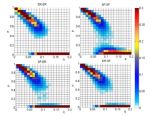EPJ B Highlight - Inter-dependent networks stress test
- Details
- Published on 31 July 2014

A new study relies on a complex systems modelling approach, known as graph theory, to analyze inter-dependent physical or social networks and improve their reliability in the event of failure
Energy production systems are good examples of complex systems. Their infrastructure equipment requires ancillary sub-systems structured like a network - including water for cooling, transport to supply fuel, and ICT systems for control and management. Every step in the network chain is interconnected with a wider network and they are all mutually dependent. A team of UK-based scientists has studied various aspects of inter-network dependencies, not previously explored. The findings have been published in EPJ B by Gaihua Fu from Newcastle University, UK, and colleagues. These findings could have implications for maximising the reliability of such networks when facing natural and man-made hazards.
Previous research has focused on studying single, isolated systems, not interconnected ones. However, understanding inter-connectedness is key, since failure of a component in one network can cause problems across the entire system, which can result in a cascading failure across multiple sectors, as in the energy infrastructure example quoted above.
In this study, interdependent systems are modelled as a network of networks. The model characterizes interdependencies in terms of direction, redundancy, and extent of inter-network connectivity.Fu and colleagues found that the severity of cascading failure increases significantly when inter-network connections are one-directional. They also found that the degree of redundancy - which is linked to the number of connections - in inter-network connections can have a significant effect on the robustness of systems, depending on the direction of inter-network connections.
The authors observed that the interdependencies between many real-world systems have characteristics that are consistent with the less reliable systems they tested, and therefore they are likely to operate near their critical thresholds. Finally, ways of cost-effectively reducing the vulnerability of inter-dependent networks are suggested.
G. Fu, R. Dawson, M. Khoury and S. Bullock (2014), Interdependent networks: Vulnerability analysis and strategies to limit cascading failure, European Physical Journal B 87: 148, DOI: 10.1140/epjb/e2014-40876-y




